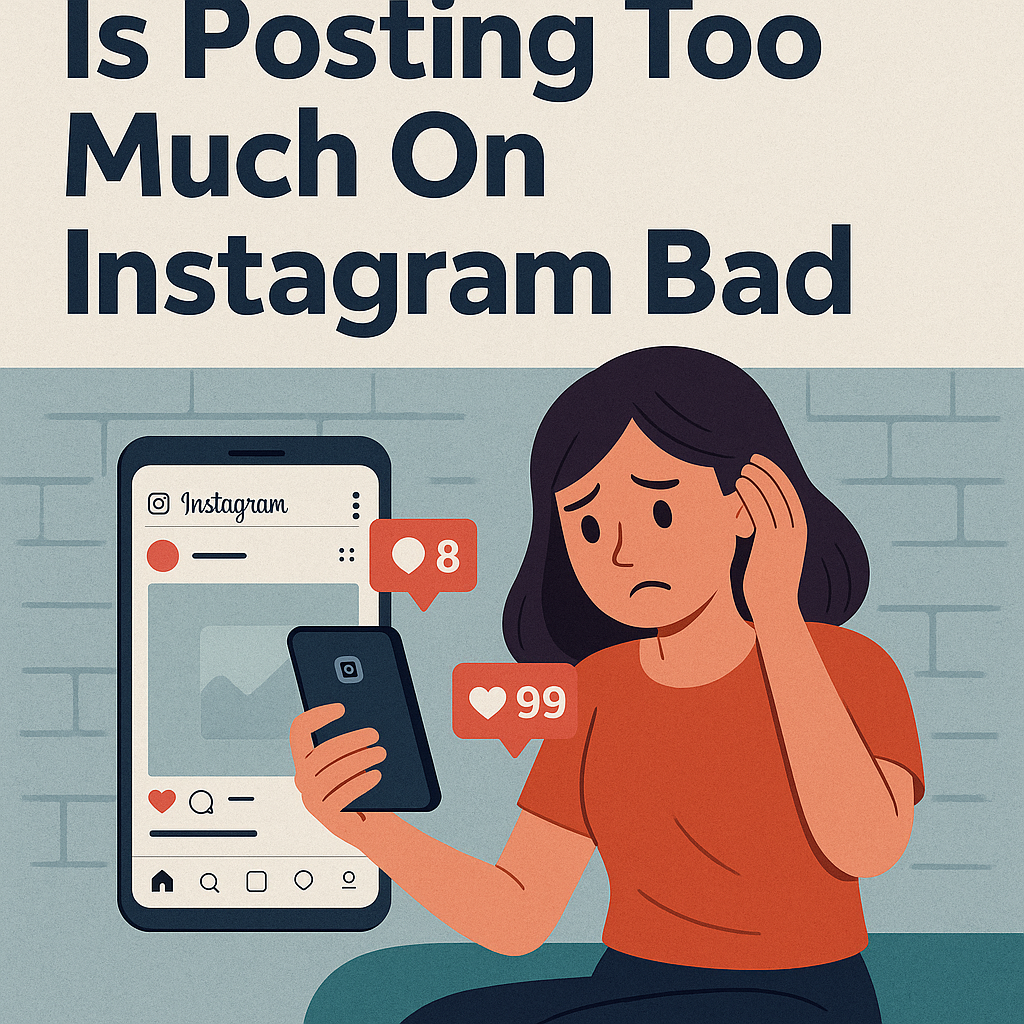Social platforms need continuous fresh updates but determining the optimal posting frequency remains a challenge. This article investigates the delicate boundary between maintaining active presence and exceeding the acceptable limits of posting content. The article examines excessive posting through industry research and platform analytics to determine its impact on audience reception.
Major networks including Facebook and LinkedIn show that feed clutter leads to decreased user engagement. Regular posting helps increase visibility yet excessive posting to followers can produce negative results. Both personal profiles and brand accounts face decreased engagement when their content becomes repetitive or irrelevant.
The social media landscape continues to prioritize quality content above all else. A well-made single post delivers better results than multiple hasty updates. Experts recommend scheduling content strategically instead of focusing on quantity because it helps users reach their audience during optimal times and align with platform rules.
Key Takeaways
- The number of updates should be balanced because excessive posting leads to decreased engagement rates
The algorithms of platforms give preference to high-quality content instead of the quantity of posts
The feeling of fatigue among audiences develops when their feeds become too crowded
The ideal number of posts per week depends on the specific niche and the number of followers you have
Analytics tools enable you to determine the optimal posting frequency for your account
This article presents established methods to maintain visibility through community-friendly posting schedules. The following guide explains how to develop a content rhythm which sustains audience engagement through pattern analysis and strategic posting timing.
Understanding Instagram Posting Frequency
The foundation of an effective social media strategy depends on determining the optimal time to share content. The number of posts you publish determines how often your content shows up in feeds while maintaining a balance between visibility and feed saturation. Your followers will stay engaged when you post correctly without reaching the point where they lose interest.
Many creators wonder is it bad to post multiple times a day on instagram when building their content strategy. Questions about is posting everyday on instagram bad reflect concerns about algorithm penalties and audience fatigue. The risk of over posting on social media can lead to unfollows and decreased engagement rates.
Understanding how many posts is too many on instagram depends on your audience preferences and content quality. Knowing the instagram daily post limit helps avoid technical restrictions while maintaining consistent presence. Creators ask is it bad to post everyday on instagram when planning content calendars.
Concerns about is it bad to post more than once a day on instagram vary by niche and follower expectations. Wondering is it bad to post on instagram twice a day requires testing audience response rates. Avoiding too much posting on social media maintains quality over quantity for sustainable growth.
Defining Post Frequency Across Platforms
Every network has unwritten rules. Twitter requires users to post 3-5 updates daily for optimal performance while LinkedIn recommends publishing 1-2 thought-leadership pieces per week. Instagram achieves its best results with daily visual content through 1-2 grid posts. The algorithms of platforms support consistent posting but will punish users who post spam-like content.
| Platform | Suggested Daily Posts | Peak Days | Peak Times |
|---|---|---|---|
| 1-2 | Weekdays | 11 AM – 2 PM | |
| 1-2 | Weekends | 1 PM – 4 PM | |
| 3-5 | Weekdays | 8 AM – 9 AM |
Quick Common Asked Question and Answer
The act of posting frequently on Instagram remains beneficial when you maintain high-quality content even though posting multiple times each day might cause negative effects.
Yes, does posting more on Instagram help—but only if you’re maintaining quality. The visibility of your content increases through regular posting alongside effective use of hashtags at strategic times. Your Instagram content may become negative when you post multiple times a day if your posts feel hurried or repetitive. The algorithm experiences fatigue because of too much posting which reduces the reach of your content. Focus on value, not just volume.
Industry and Audience Considerations
The retail sector needs to post daily products while educational accounts share content 3-4 times per week. Your follower activity patterns can be found through Instagram Insights which shows when your audience becomes active. Local businesses need to synchronize their posts with local events and time zones.
By following a quality-first approach you can preserve your consistency without sacrificing the value of your posts. Fashion influencers maintain a schedule for Reels by posting them every other day yet photographers choose to post carousels weekly. You should experiment with different posting times before monitoring engagement metrics to identify your brand’s natural posting schedule.
Your Instagram posting frequency becomes bad only when your content quality and audience interaction decrease rather than when you post twice daily as both situations can increase visibility through strategic valuable content sharing but posting daily on Instagram only becomes negative when it results in overwhelming your followers with repetitive or low-quality content.
Is Posting Too Much On Instagram Bad for Your Business?
Businesses maintain a delicate equilibrium between remaining visible and creating fatigue among their audience followers. Too many feed updates can cause loyal customers to lose interest. We will discuss the performance effects of continuous brand updates.
Risks of Overposting and Audience Overload
Frequent uploads can backfire. Research from Sprout Social in 2023 showed accounts that post more than three times per day experience a 34% decline in engagement compared to single-post accounts. Overexposure to identical promotional content creates fatigue among followers.
A boutique clothing brand raised their weekly posting amount from 5 to 10. Although the company produced more content the customer numbers dropped by 18% since customers expressed feeling overwhelmed. The marketing lead observed that their feed started to repeat itself. Your core message gets diluted when you fill your feeds with excessive content so quality becomes more important than quantity.
Impact on Engagement and Visibility
The Instagram algorithm bases its priority on meaningful interaction between users. Accounts that flood feeds usually experience reduced reach because the system identifies them as unimportant content. A technology startup decreased its daily post total to three weekly posts and observed a 41% rise in per-post like counts.
Media platforms which present excessive content may face the danger of users leaving. Users maintain 500+ active accounts so your posting schedule needs to follow a well-planned timing strategy to differentiate from others. Later provides recommendations for posting intervals between 4-6 hours which help users stay visible without overwhelming their followers.
Balance remains key. Check your save rates and comments to determine if your posting schedule matches what your community prefers. Each valuable update becomes more effective than the traditional quantity-focused approach.
The following FAQ includes answers to your Instagram posting frequency questions.
Q: I am posting too much on instagram and what does it mean to overpost on instagram? Your engagement statistics determine whether you post too much on Instagram rather than a fixed posting limit. The main indicator of overposting on Instagram appears through lower like counts and comment engagement and reduced reach numbers even though you publish more content. Successful accounts reach their highest engagement by posting between 3-5 times per day but the quality of content matters more than the number of posts. The following indicators show you are overposting: follower drop-offs, decreased engagement rates, reduced story views, and audience fatigue comments. The typical account achieves success by publishing 1-2 well-made posts each day along with a maximum of 3-7 stories. Review your analytics to see how engagement changes when you increase your posting rate because this will help you decide when to adjust your content output. It is always preferable to post valuable content less frequently than to spam users with low-quality content because this trains the algorithm to display your content to fewer viewers. The decision to post daily on Instagram depends on your content value and audience reception instead of the posting frequency itself because strategic high-quality content can enhance visibility.
Your audience preferences determine how often you should post on Instagram since overposting leads to decreased engagement and follower annoyance. The optimal number of daily posts on Instagram differs across niches but most accounts succeed when they post no more than 3-4 times per day. The decision to post twice daily on Instagram depends on the quality of your content and what your followers expect while most accounts reach peak engagement through daily or less frequent posting.
The impact of posting twice daily on Instagram depends on the combination of your content quality and audience engagement rather than the posting frequency alone because posting two valuable posts daily can increase visibility but posting two average posts daily will decrease engagement rates more than posting one exceptional piece thus focus on quality content while using analytics to determine your audience’s content appetite.
Optimizing Your Instagram Posting Schedule
Mastering Instagram’s rhythm requires more than guesswork. Successful accounts blend data insights with creative instincts to find their unique cadence. Let’s explore practical methods to refine your approach.
-
Aspiring interior designers can gain clarity on legal, branding, and client acquisition strategies by reviewing our in-depth post on starting a professional interior design practice.
Finding Your Ideal Frequency
Start by tracking when your people interact most. A fitness coach discovered their audience engaged 37% more on weekday mornings after analyzing Instagram Insights. Test different schedules for 2-3 weeks, then compare results.
| Post Frequency | Likes/Day | Comments/Post | Story Views |
|---|---|---|---|
| 1 daily | 420 | 28 | 1,200 |
| 3 weekly | 580 | 41 | 1,850 |
| 5 weekly | 390 | 19 | 980 |
The local bakery demonstrates superior performance through mid-frequency posting instead of daily updates according to their case study. The bakery marketing team changed their posting strategy to three quality-focused updates per week which resulted in a 62% increase in saves.
Testing and Analyzing Engagement Metrics
Choose engagement signals above vanity metrics for your marketing strategy. The travel blogger achieved a 22% increase in followers through his focus on story replies instead of likes. Track which photos get shared versus those that get scrolled past.
Hootsuite provides cross-platform tools that help you evaluate Instagram performance against other networks. The eco-brand discovered their carousel posts performed better during weekend hours but their stories generated more engagement during lunchtime.
Your optimal posting time will transform as your audience develops new habits. Check your performance quarterly through native analytics and third-party dashboards to maintain alignment with changing audience behaviors.
If you’re unsure about valuing your creative output, this article on Instagram Reels pricing insights for creators provides a structured approach.
Enhancing Engagement with High-Quality Content
What separates memorable accounts from forgettable ones? Often, it’s the caliber of their visuals and captions. While consistency matters, your content strategy needs razor-sharp focus on value delivery through diverse formats.
Instagram creators frequently wonder is posting multiple times a day on instagram bad when developing their content strategy and engagement tactics. Many ask does posting more on instagram help to understand the relationship between posting frequency and audience growth.
Posting frequency concerns include is posting twice a day on instagram bad and overposting on instagram for optimal engagement without overwhelming followers. Self-assessment questions involve am i posting too much on instagram and overposting instagram for content strategy evaluation.
Content moderation includes is it bad to post a lot on instagram and is it bad to post twice a day on instagram for sustainable posting practices. Platform behavior analysis involves over posting on instagram and does posting everyday on instagram help for daily posting strategies.
Social media best practices include excessive posting on social media and how much is too much posting on instagram for general guidelines. Daily posting considerations involve is it bad to post on instagram everyday and is posting twice a day on instagram too much for frequency optimization and audience retention strategies.
Crafting Engaging Captions and Visuals
Stunning images grab attention—but words keep it. A travel blogger increased saves by 73% by pairing mountain vistas with questions like “Where’s your next adventure?”. Use tools like Canva for cohesive aesthetics, and always align visuals with your brand voice.
Food accounts thrive when showing sizzling pans alongside recipe hacks. One bakery grew followers 89% using carousel posts showing step-by-step process shots. Remember: Every pixel should tell part of your story.
Balancing Quantity with Content Quality
Create a rhythm that sustains interest without burnout. A skincare brand uses themed weeks—Mondays for tutorials, Fridays for user testimonials. This strategy maintains variety while keeping production manageable.
“Batch-creating content every 21-day period lets us focus on engagement,” explains a lifestyle influencer. Use scheduling tools to space posts 4-6 hours apart, giving each update room to breathe.
Quick Common Asked Question and Answer
Can you post too much on Instagram and what happens if you overdo it?
Yes, can you post too much on Instagram is a valid concern. While frequent posting can boost visibility, overposting—especially multiple times a day without quality—can lead to audience fatigue and reduced engagement. If you’re asking is posting on Instagram everyday too much, the answer is no, as long as content remains valuable and consistent. However, posting too much on social media can make your content feel spammy. What happens if you post too much on Instagram? You might see lower reach per post, follower drop-off, or a decrease in meaningful interactions. Balance is key.
Leveraging Stories and Diverse Media Formats
Stories drive 35% of profile visits for top accounts. Mix polls, quizzes, and behind-the-scenes clips to spark interaction. Beauty brand Glossier uses Story highlights as permanent product catalogs—a clever way to repurpose content.
Experiment with Reels for tutorials and IGTV for longer narratives. A fitness coach doubled shares using 15-second workout clips on platforms like Reels. Track which formats resonate using Instagram Insights’ retention graphs.
Conclusion
Building a thriving Instagram presence hinges on smart strategy rather than constant activity. Finding your ideal rhythm means balancing regular updates with high-value content that sparks meaningful interactions. Accounts that prioritize growth through strategic scheduling often see better reach than those posting multiple times daily without purpose.
Overloading feeds risks disengagement, while curated posts foster loyalty and expand your reach. Track comments and shares to gauge what resonates. Tools like videos and carousels can boost visibility when used thoughtfully—quality always trumps quantity.
Refine your approach by testing different times and formats. Successful creators analyze metrics like comments weekly, adapting their schedule based on follower behavior. Remember: sustainable growth comes from consistency paired with audience insights.
Ready to optimize? Start today by auditing your content calendar. Small tweaks to your posting schedule and focus on authentic engagement can transform your account’s performance over time.
Q: Is posting every day on instagram bad, and can posting too much on instagram be bad for engagement?
A: Wondering is posting every day on instagram bad is a common concern, and the answer depends on your content quality and audience expectations. While daily posting isn’t inherently harmful, can posting too much on instagram be bad? Yes, if you’re sacrificing quality for quantity. The question does instagram punish you for posting too much has a nuanced answer – Instagram’s algorithm doesn’t directly penalize high-frequency posting, but follower fatigue can lead to decreased engagement, unfollows, and reduced reach. Even practices like is double posting on instagram bad depend on context – spacing posts appropriately and maintaining quality matters more than strict frequency rules.
Q: Is it better to post more or less on instagram, and is posting 3 times a day on instagram too much?
A: When considering is it better to post more or less on instagram, quality should always trump quantity. The sweet spot varies by niche – lifestyle accounts might thrive with 1-2 daily posts, while news or meme accounts could post more frequently. Asking is posting 3 times a day on instagram too much often indicates overposting on social media territory for most accounts. Studies suggest 1-2 posts per day maximum for most niches, with stories filling the gap for additional content. The key is consistency and value – posting less frequently with high-quality, engaging content typically outperforms frequent mediocre posts. Monitor your analytics to find your audience’s preference and adjust accordingly.







